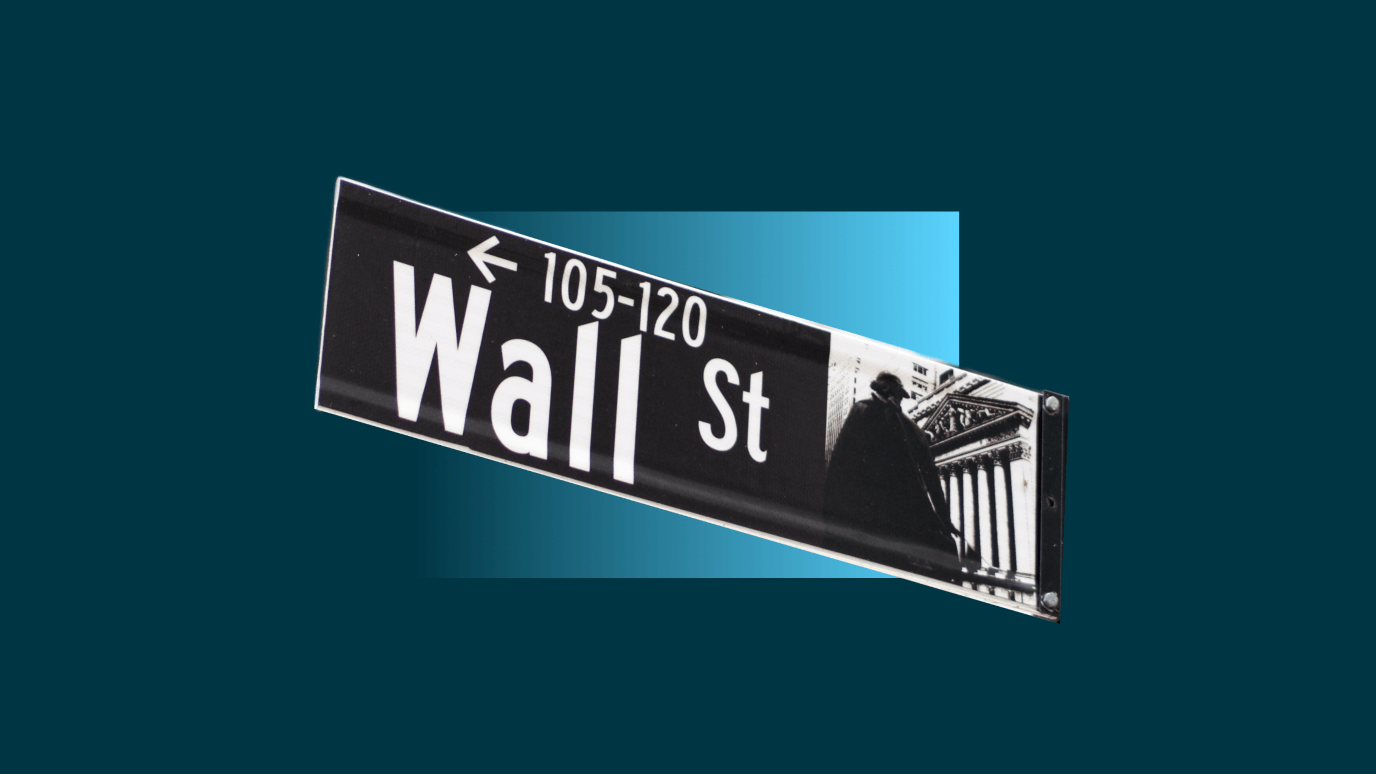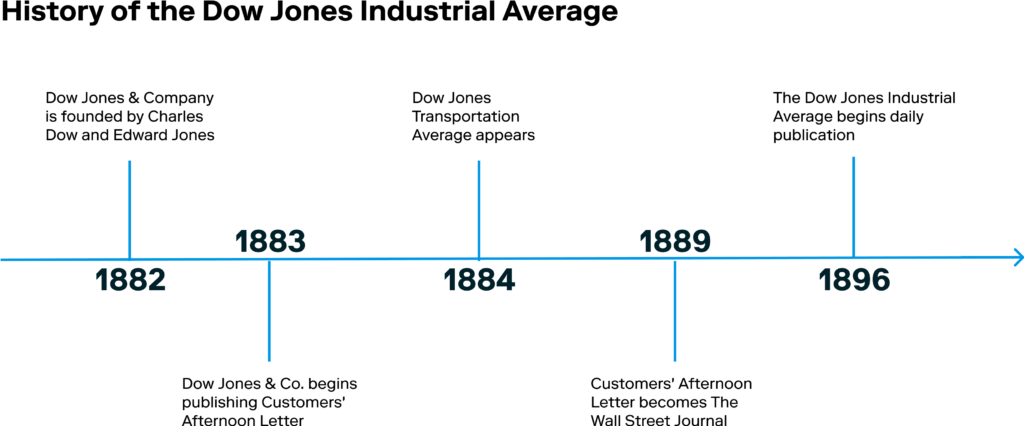Oct 18, 2023
What is the Dow Jones Industrial Average (DJIA)?

| What is the Dow Jones Industrial Average (DJIA)? The Dow Jones Industrial Average (DJIA) is a stock market index that measures the performance of 30 large, publicly-owned companies listed on the New York Stock Exchange (NYSE) and the NASDAQ stock exchange. It is one of the oldest and most widely-watched stock market indices in the world. |
Whether you call this stock index the Dow, the Dow Jones, DJIA, or by its full and gloriously long name, the Dow Jones Industrial Average is a name you’ve heard at some point or another. And since you’re here, it’s likely a name and stock index you’d like to become more familiar with.
The Dow Jones Industrial Average has an incredibly rich history, leaving a heavy footprint on how we gauge the United States stock market to this very day. In the world of finance, the Dow Jones index provides a snapshot of how its selected companies are performing in the stock market and is an indicator of the overall health of the U.S. economy.
In this article, we’ll cover:
- Why the Dow matters
- History of the Dow Jones Industrial Average
- Stocks included in the Dow
- How the Dow is calculated
- The Dow vs other market indexes
- How to invest in the Dow Jones
Why the Dow Jones matters
Investors and financial analysts use the Dow as a benchmark to compare the performance of their own investments or portfolios. Because indexes like the Dow hold companies from a wide range of economic sectors, investors can gain a quick understanding of how the market is performing and whether a particular section of the economy is weakening.
History of the Dow Jones Industrial Average
So who exactly is ‘Dow Jones’? The Dow was named for an existing company, but Dow and Jones were real people that made an unforgettable impact on Wall Street and the investing world.
Like any good story, this one begins with friendship. Financial journalist, Charles Dow, and statistician, Edward Jones, met in the late 19th century while working at the Providence Evening Press. Both shared a fascination with the financial markets and recognized the need for a better, unbiased system of reporting on stocks and other financial instruments.
After leaving the Providence Evening Press in 1882, Dow and Jones headed to New York to found their own financial news service, the Dow Jones & Company. The pair, along with their silent partner, Charles Bergstresser, later went on to create The Wall Street Journal.
Creating the Dow Jones index
Charles Dow wanted to create a way to track the overall performance of the U.S. stock market. He selected 12 companies that he believed were representative of the economy at that time including companies like General Electric, American Tobacco, and U.S. Leather.
Here are the original 12 companies the Dow first tracked:
- American Cotton Oil
- American Sugar
- American Tobacco
- Chicago Gas
- Distilling & Cattle Feeding
- General Electric
- Laclede Gas
- National Lead
- North American
- Tennessee Coal and Iron
- U.S. Leather
- U.S. Rubber
You can see the companies selected for the index fall into the industrial category, giving more meaning to the word ‘industrial’ in the index’s name.
And with that, the Dow Jones Industrial Average was officially established and debuted on May 26, 1896, in The Wall Street Journal. Now that’s good publicity.

How the Dow Jones changed over time
Since its creation, the DJIA has changed significantly to reflect changes in the economy and the stock market. The index’s list of 12 companies grew to 20, then grew to 30, and companies were removed and replaced throughout the years by its averages committee on an ‘as-needed basis’.
In 2018, General Electric (GE), the last remaining company from Charles Dow’s original selection, was removed from the index. After underperforming in its sector for several years, the company was replaced with Walgreens. This move allowed the Dow to be more representative of the consumer and healthcare sectors and better reflect the US economy.
Today, the DJIA includes companies from a range of sectors, including technology, healthcare, and consumer goods.
Companies on the Dow Jones Industrial Average in 2023
The Dow Jones includes companies across the spectrum, but primarily holds blue chip companies representing the industrial and consumer goods sectors. Each company within the index is selected because they’re considered leaders in their sectors. Here are the 30 companies in the DJIA by index weight as of 2023:
| Company | Date added to the DJIA |
|---|---|
| UnitedHealth Group Incorporated | September 24, 2012 |
| Microsoft Corporation | November 1, 1999 |
| Goldman Sachs Group Inc. | April 2, 2019 |
| Home Depot Inc. | November 1, 1999 |
| McDonald's Corporation | October 30, 1985 |
| Amgen Inc. | August 31, 2020 |
| Visa Inc. | September 20, 2013 |
| Caterpillar Inc. | May 6, 1991 |
| Salesforce Inc. | August 31, 2020 |
| Boeing Company | March 12, 1987 |
| Honeywell International Inc. | August 31, 2020 |
| Apple Inc. | March 19, 2015 |
| Travelers Companies Inc. | June 8, 2009 |
| Walmart Inc. | March 17, 1997 |
| Procter & Gamble Company | May 26, 1932 |
| Johnson & Johnson | March 17, 1997 |
| American Express Company | August 30, 1982 |
| Chevron Corporation | February 19, 2008 |
| International Business Machines Corporation | June 29, 1979 |
| JPMorgan Chase & Co. | May 6, 1991 |
| NIKE Inc. | September 20, 2013 |
| Merck & Co. Inc. | June 29, 2013 |
| 3M Company | August 9, 1979 |
| Walt Disney Company | June 5, 1976 |
| Coca-Cola Company | March 12, 1987 |
| Cisco Systems Inc. | June 8, 2009 |
| Dow Inc. | May 6, 1987 |
| Intel Corporation | January 11, 1999 |
| Verizon Communications Inc. | April 8, 2004 |
| Walgreens Boots Alliance Inc. | June 26, 2018 |
Most of these companies fall into three main sectors: information technology (21.65% of the DJIA), health care (17.58%), industrials (15.78%), and financials (15.57%).
How is the Dow Jones Industrial Average calculated?
The Dow Jones is calculated by taking the sum of the stock prices of the 30 companies and dividing it by a number called the Dow divisor. The Dow divisor is a constant that is adjusted to account for changes in the stock prices and any corporate actions, such as stock splits or mergers.
To calculate the value of the Dow, the stock prices of each of the 30 companies are added up, and the sum is divided by the Dow divisor. The resulting number represents the current value of the Dow.
Dow Jones vs other stock indices
All stock market indexes track market performance; how they do that differs from index to index. These indexes can track a certain group of stocks and are often grouped around a particular industry.
Unlike other stock market indexes, such as the S&P 500 and the Nasdaq Composite, which are market capitalization-weighted indexes, the DJIA is a price-weighted index. This means that a higher-priced stock will have a greater impact on the index’s value than a lower-priced stock, regardless of the company’s size or market capitalization.
Another difference between the Dow and other stock market indexes is the number of companies it tracks. The DJIA tracks only 30 companies, while the S&P 500 tracks 500 companies and the Nasdaq Composite tracks more than 2,500 companies.
So is one index better than another?
All three market indexes are widely used and highly regarded. But while the DJIA is used as a shorthand for the performance of the U.S. stock market, its narrow focus on just 30 stocks makes it a less comprehensive representation than the S&P 500, for example. Each index has its own strengths and weaknesses so as an investor, it’s important to look at more than one index.
Investing in the Dow Jones Industrial Average
So can you invest in the Dow Jones? Yes, but not directly. While you can’t invest in a market index, you can invest in the DJIA through exchange-traded funds (ETFs) that track the index, mutual funds that invest in companies included in the index, or by purchasing shares in the individual companies that make up the index.

Investing made easy.
Start with any dollar amount today.

Dow Jones Industrial Average FAQ
How many stocks are in the Dow Jones?
The Dow Jones Industrial Average consists of 30 blue chip companies from a range of sectors, including technology, healthcare, and consumer goods.
What determines which companies are in the Dow?
The DJIA has no hard and fast rules on how a company’s stock is added to its index. Besides the requirement of already being a security on the S&P 500, a stock is typically added only if the company has an excellent reputation, demonstrates sustained growth, and has a large number of investors interested.
Can you buy Dow Jones stock?
While you can’t buy the Dow Jone directly, you can invest in the DJIA through exchange-traded funds (ETFs) that track the index, mutual funds that invest in companies included in the index, or by purchasing shares in the individual companies that make up the index.
Related Articles

15 Largest AI Companies in 2024

The 12 Largest Cannabis Companies in 2024

What Is a Traditional IRA?

Saving vs. Investing: 2 Ways to Reach Your Financial Goals

How To Invest in the S&P 500: A Beginner’s Guide for 2024

Stock Market Holidays 2024





